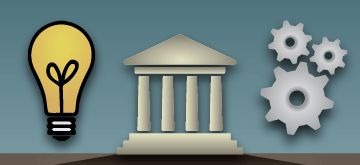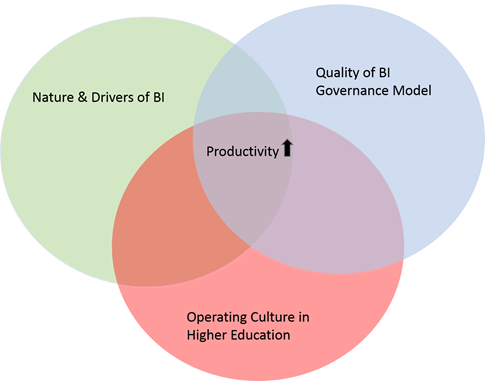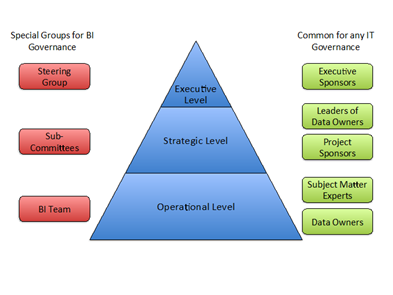Business intelligence success is contingent on three key concepts: the nature and drivers of BI, the quality of the BI governance model, and the operating culture in higher education. Good governance plays a critical role by ensuring a nimble BI enterprise that minimizes decision delays and leads to customer delight.

We've all been in meetings where smart, gifted individuals discuss varied topics for an hour or so, but when we leave it's unclear what decisions were made. Many factors contribute to these types of scenarios, one of which is governance.
Good governance is a fundamental requirement for successful business intelligence (BI). Distilled down to its purest essence, governance is about decision making, even when the decision is to wait until more is known about a particular issue. Whether you are a business or technology officer, good governance results in shared understanding about strategy, roles, resources, and priorities.
Of course the key term here is "good." Governance and the members of governance groups must be clear, accountable, and active. Otherwise, basic questions — Who will make the necessary decisions and at what levels? What decisions need to be made and when? How will decisions be implemented and monitored? — can result in months and even years of seemingly endless delays.
Why does answering such basic questions seem so challenging? The answer principally hinges on our effectiveness in navigating three BI concepts, as shown in figure 1:
- The nature and drivers of BI
- The quality of the BI governance model
- The operating culture in higher education

As institutions concurrently improve management of these three concepts, productivity increases.
The Nature and Drivers of BI
In any project or organization, resources, accountability, trust, leadership, and ownership are critical. However, with BI, the issue of ownership is much more involved, and good governance plays a pivotal role in paving the way for success.
Complementary Ownership by Functional, Academic, and Technical Staff
No matter the strength and capabilities of a university's technology organization, academic and administrative stakeholders — the data owners and drivers — must be part of the governance structure for any BI initiative to succeed.
"Shared ownership of BI is the most important success factor."
BI deliverables vary from multidimensional online analytics processing, or OLAP, cubes, to graphic visualization tools and beyond. Regardless of the form, BI crystallizes data from several subject areas to help leaders in our university communities make better business decisions. By contrast, enterprise resource planning (ERP) toolsets are primarily designed for processing operating transactions in the context of business rules focused on a single subject area.
In this fundamental respect, the way in which shared ownership bears on the success of a BI initiative is different in kind, not just degree. While technology plays a significant role, the most central BI stakeholders are not the technologists, but the other academic and administrative leaders who serve alongside them. Several institutions have tried to drive their campuses into the BI field through the strength of their technology organizations, only to see the initiatives falter and no sustainable change in the way decisions are made.
"Technical talent needs the support of good governance."
At UT Austin and UT System Administration in the 1990s, the institutions spent millions of dollars on technology-led data warehouse initiatives. Massive amounts of data were taken from various legacy systems, transformed, and dumped into relational databases, and users were given query tools to begin accessing and writing custom reports. Despite major efforts, neither data warehouse was widely used or transformative in helping university leaders make more timely and informed decisions.
Although other factors hindered these initiatives from achieving the desired results, a primary reason was that the true drivers or data owners (the financial, student, academic, and human resource professionals) were not significantly connected via good governance. When the IT teams made the data available in the warehouses, they saw the job as complete, although the resulting impact was negligible. Having advised many dozens of institutional BI leaders across the country for the past decade, I've found that experiences like this are all too common in higher education.
Resources
As with any initiative, resources, including funding for tools as well as talent, play pivotal roles. Some special personnel are needed in the world of BI, such as ETL (extract, transfer, and load) developers, data architects, data modelers, and a unique type of business analyst. It helps to have at least a few of these individuals melded into the BI decision-making grid, even if just at an operating governance level.
Accountability
In addition to issues of resources and organizational ownership, another driver that can significantly affect the quality of governance and decision making is ongoing accountability. Due to the nature and expected frequent use of BI reports and cubes, coupled with the varied data owners and source systems, all governance players must embrace the following responsibilities:
- Get the product(s) out: A critical success factor for this need is to identify and clearly commit to the target audience and purpose for the BI solution, even if it's unpopular with some. As a former boss of mine used to say, "If you're not careful, you end up trying to 'boil the ocean,' and nothing of use gets delivered."
- Monitor solutions once published: Don't assume that once a deliverable is in use, the work is done. Watch usage and ensure the intended audience is actually using the tool(s). Monitoring and refinement also help address missing contexts, which become important as audiences adopt the tools and realize they need more information.
I've heard far too many stories of thousands of hours and countless dollars going into a deliverable, only to find out months or even years later that no one uses it because the solution either wasn't easy to use, didn't answer the core questions, or tried to address the concerns of too broad a target audience. Good governance is not a panacea, but it can help limit the number of these stories at your campus.
High Trust and Open Communication
"The problem with communication is the illusion that it's been accomplished."
—George Bernard Shaw
Accountability doesn't just happen; it is a result of something much more difficult to achieve — high trust and vulnerable communication among leaders and teams. Decision making depends on and works better with healthy team building. Great teams have the following qualities:
- Room for creative conflict when necessary — a certain amount of conflict is healthy, because an organization without conflict is probably missing trust
- Self-awareness, trust, and vulnerability between members of the group
- Shared priorities and commitment to achieving goals
- Peer accountability
- A focus on results
Perhaps the easiest way to understand this driver is to gain a greater sensitivity to knowing when these qualities are absent. Increased frequency of meetings, longer meetings, e-mail trails resulting in "blamestorming," and disengaged behaviors are signs of dysfunction and lack of trust. I highly recommend Patrick Lencioni's The Five Dysfunctions of a Team, which provides a creative and insightful approach to addressing these concerns. The principles are not just true for BI or even higher ed — they apply to all forms of group interaction.
Although the usual tendency is for IT and business professionals to replace in-person meetings with e-mail and texts, it is still best to connect via video conference or meet in person with key colleagues, at least until sufficient trust and understanding have gained a foothold.
Leadership
Finally, even when sufficient resources, ownership, accountability, and trust are present, leaders who work hard and put other's needs ahead of their own teams' needs are a critical ingredient. This is true in all areas as well as BI, and it is still necessary to avoid self-protective "fiefdoms" on campus. In addition to the other-centered attitude and work ethic, leaders need a vision and the ability to effectively communicate the promise of the BI field to a diverse group of customers and university stakeholders.
The Quality of the Governance Model
Depending on the size and complexity of an institution and its BI vision, governance takes on a variety of forms. The governance structure used for many years by UT Austin's groundbreaking BI and data warehousing project, Information Quest (IQ), had three primary tiers, or levels — executive, strategic, and operational — involving a number of decision-making bodies, also known as governance groups. Some groups should be part of any governing structure, but a few from this model were specifically established because of the drivers of BI effectiveness and the way we make decisions in higher education (see figure 2).

Executive Level: Groups and Contributions
At the executive level, due to the size and departmental focus of IQ, UT had two governance groups, the executive sponsors and the IQ Steering Committee. Executive sponsors focused on resolving strategic budget and resource issues, while the steering committee led the data directions and work to be done by highlighting the most pressing issues and questions that the community needed insight into. Both groups, and all other governing bodies, followed IQ's guiding principles:
- Start small and grow in manageable increments
- Keep investments in line with results
- Leverage existing transactional systems
Oversight mechanisms for the executive-level governing bodies included semiannual updates and annual planning meetings.
An illustration of the pivotal role played by the executive sponsors occurred when IQ was experiencing growing demand beyond the capacity of the relatively small team in 2004, and UT was in very challenging times financially. The executive sponsors, with input from the steering committee members, advocated for IQ to the University Budget Council, resulting in priority being given to IQ. These same sponsors put IQ above many compelling needs in their own units and around the university. That year, the IQ team was one of only three units that received an increase in ongoing budgeted funds.
Strategic Level: Groups and Contributions
At this level, the strategic directives of the steering group are further broken down. The purposes of the governance groups on this level are to prioritize deliverables within subject areas, resolve strategic issues, and, on rare occasions, elevate issues as appropriate. These governance leaders are also responsible for reviewing the completeness, accuracy, and timeliness of data and deliverables. Output examples include decisions involving complex data definitions, data accessibility, and solution diagrams and dependency documentation.
Project sponsors met on a weekly basis and, depending on the scope and status of a project, subcommittees met more or less frequently. Looking back, I feel the trust and shared ownership at this level with this group fueled the very heart and soul of IQ.
Subcommittees, often consisting of steering committee delegates, helped refine the deliverables, perform beta testing, review business rules, and assist in QA and data validation. These groups also assisted in evaluating and improving the metadata associated with the subject areas, cubes, reports, and project as a whole.
Data stewards reviewed and validated the accuracy of all aspects of data loaded into the warehouse, particularly the information used in specific BI deliverables.
Examples included:
- Defining and deciding what data to load and how often to refresh it
- Handling authorizations for who can access data and reports
- Working with other data stewards on the creation and maintenance of crosswalks for integration
- Monitoring and adjusting the data to ensure its completeness, accuracy, and timeliness
- Creating and leading a data steward team for their area of expertise, including technical analysts and nontechnical users, to assist in carrying out the responsibilities outlined above
- Resolving any issues related to data, including ensuring that the proper resources are made available from their respective areas to ensure proper loading and review after the fact
Data stewards met on a monthly basis with the project sponsors and project director to receive an update on project status, resolve any data-related items, and conduct a quality review of all milestones.
Operational Level: Groups and Contributions
The operational level is the most granular, and it usually involves delegates of steering or subcommittee members. Higher ed organizations typically have governance groups at the executive and strategic levels, but lack the decision-making elements listed, or allow groups that should be at this level to operate at a higher level.
To illustrate this principle, until recently the Telecommunications and Networking group at Illinois State University (ISU) operated outside its broader IT governance structure. Although this team was only peripherally related to the BI operation, failing to include the Telecommunications and Networking group with the other technical, administrative, and departmental leaders in the governance process ultimately led to a severely bloated budget and dissatisfied community of customers. Since the group was generally allowed to plan, prioritize, and fund projects outside of campus-wide IT governance for many years, it operated at a de-facto executive level, making BI and other initiatives take a back seat. With cloud BI options becoming more available, particularly for smaller institutions, the need to include the network team in governance is becoming increasingly important.
At UT Austin, decision areas at this level included infrastructure, resource and capacity planning, and monitoring. The policies guiding the operational governance bodies were:
- Define project results, plans, and scope in detail
- Get the right people involved, committed, and supported
- Establish a change and enhancement management procedure
Oversight mechanisms included weekly meetings within teams focusing on specific deliverables and with data owners and subject matter experts.
Together, all the executive, strategic, and operational levels worked synergistically with the broader university IT governance structure as a unified governance community.
The Operating Culture in Higher Education
Tenure, state worker entitlement, an avoidance of change or transparency, risk-averse administrators, and seemingly impenetrable organizational silos breed the perfect environment to stagnate a cross-functional program like BI. As higher ed leaders we must be introspective, creative, and courageous in finding ways to stem this cultural tide.
Unfortunately, even with a good governance structure and appropriate consideration of BI's drivers, some initiatives at UT Austin took a long time to get into production. One example involved a tool that was developed as an OLAP cube showing organized research activity over multiple years, viewable in a variety of dimensions and levels. Whenever the cube was demonstrated to deans and vice presidents, there was an overwhelming sense of appreciation and interest, invariably ending with, "When can we have it?"
In retrospect, not finding a way to involve key stakeholders from the beginning, and being unable to get them engaged after the fact, led to a nine-year delay to releasing this deliverable into production. The tool did benefit the pre- and post-award research administration units over these years, but the full release to the principal investigators and broader research community took some time. The concerns were eventually addressed, and the cube was released into production due to the herculean efforts of a vice provost who was willing to make difficult decisions and see them through to the end.
Conclusion
Facilitating success within the BI enterprise is a complex endeavor, and beyond the elementary principles mentioned above, a few other key factors can help make or break your campus BI initiative:
- Taking a "crawl, walk, run" approach to each new major area
- Funding centrally as much as possible to mitigate tensions with competing priorities from funding departments
- Measuring and communicating the ROI of each deliverable
- Succession planning and resourcing for key IT roles
The benefits of a good BI system are numerous, but one of the biggest advantages it brings is that it makes complex administrative decisions easier to act on. Good governance plays a critical role by ensuring a nimble BI enterprise that minimizes decision delays and leads to customer delight.
© 2013 Fred Friedrich. The text of this EDUCAUSE Review Online article is licensed under the Creative Commons Attribution-NonCommercial-NoDerivs 3.0 license.
